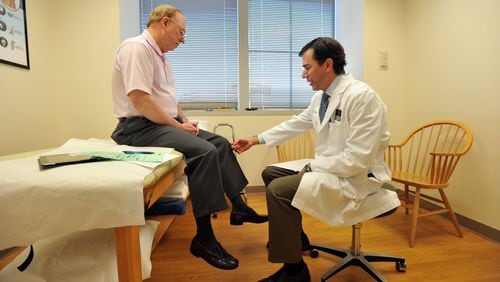Harris Simpson
Harris Simpson says that without his three joint replacements – two knees and a hip – he would be “a total cripple.”
Instead, at 80, he still bikes around Atlanta and spends hours on his feet quail hunting.
“I’m ecstatic with the results,” he said.
Simpson did have a complication and it wasn’t a minor one. Two years after having his knees done in 2008, Simpson developed a fever and discomfort in one knee. He immediately called his doctor, who admitted him to the hospital on a Saturday and immediately did surgery. It was an infection.
Because joint replacements are made of metal and plastic, it can be difficult for the human immune system to prevent bacteria that land on the man-made joints from developing into an infection.
After surgery to scrub out the infection, Simpson had to wear a little machine on his waist that administered antibiotics for three months. He’s been fine ever since.
Simpson said what caused the infection is still a mystery: The bacteria were mouth-related, he was told. People with artificial joints often need to take antibiotics before dental work, and Harris had. His doctors told him brushing his teeth too hard or even a dog licking a cut may be to blame.
Simpson said he knew how serious these infections can be: He had a college classmate who developed one while getting a joint replacement and died.
Simpson credited his surgeon, Dr. Allen McDonald III, with handling the situation perfectly.
“Allen knew what he was doing,” Simpson said.
When his hip started bothering him, Simpson didn’t hesitate to get that joint replaced too. He had it done last Christmas and all is well.
Susan Levin
Susan Levin’s joint replacement was all about staying active. She works full time, has played competitive tennis for years and loves to spend vacations taking walking tours. When she was in her 50s, painful arthritis started getting in the way. In December she opted for a hip replacement.
Levin did everything possible to prepare. She took a class for patients and followed all the guidance, down to sleeping on perfectly clean sheets the night before. She felt her doctor and the Piedmont Hospital staff handled her case perfectly.
Two weeks out, though, she noticed redness. Her doctor immediately had her screened for a blood clot or infection. With the blood clot ruled out, she took an antibiotic, but her doctor wasn’t satisfied with the response.
Levin was readmitted to the hospital, underwent a second surgery and was treated over six weeks with an IV antibiotic.
“I feel fine, and I am just thankful I had good doctors and a good hospital,” she said. “I just felt like I got great care.”
Levin plans to be back on the tennis court soon and said she would not hesitate to undergo another joint replacement if needed.
Salvatore Cassaro
Salvatore Cassaro has two knees, but he’s had four knee replacements.
Cassaro spent most of his life working airline jobs, including years bent over getting suitcases onto the planes. The work took a toll on his knees and after he retired the pain became intense.
“I got to the point I was walking bone on bone on my knee,” he said. “It was elective, but in a way it’s not. You just have to have it done.”
The first replacement didn’t last long. In about six years, the pain came back. He went in for another replacement.
“That one came out almost as good as what God gave me in the first place,” Cassaro said.
Before long, the other knee was giving out. He went back to the same surgeon, but that replacement gave him constant pain instead of relief – and Cassaro said the surgeon brushed off his complaints. Cassaro admits with a laugh that he talked to everybody about his knee pain. The original surgeon, of course, but also the mailman, his friends, the eye doctor and finally another orthopedic specialist working on his back.
That doctor referred him to a joint specialist who took a close look and redid the procedure, telling him the knee “was a complete and total mess” – the implanted joint had loosened from the bone. Hence the pain.
Finally, after the surgery, Cassaro felt good.
“The recovery and the rehab were amazing,” Cassaro said.
Thousands of patients who thought their hip replacement surgery went perfectly are getting bad news years later: Their artificial joint is defective.
Recalls and lawsuits have plagued most of the large companies that manufacture artificial hips. Many of the failures have been tied to all-metal joints that were once marketed as the best option for patients.
“There is so much competition and desire from companies to gain market share, a lot of devices have not gone through rigorous clinical trials,” said Richard Schlueter, an Atlanta attorney who has represented hundreds of clients from across the country whose artificial joints have failed.
While “metal-on-metal” joints have been the subject of most of the recalls and suits, Schlueter said failures have been associated with other joints too.
The common problem with the defective joints is that tiny pieces of metal break away from the artificial joint. That can cause damage to the nearby bone or tissue. Particles can also enter the bloodstream.
The U.S. Food and Drug Administration cautions hip replacement patients who experience pain, swelling or noise from the hip joint to contact their surgeon for evaluation.
While some doctors and hospitals may be closely watching their patients with artificial joints associated with failures, others may not, Schlueter said.
Patients who have filed lawsuits often had to undergo complicated and expensive surgeries to remove and replace defective joints.
“When these things fail,” Schlueter said, “they fail really badly.”
» YOUR TURN: Have you had hip- or knee-replacement surgery? Email cteegardin@ajc.com to tell us your story.
Thousands of patients who thought their hip replacement surgery went perfectly are getting bad news years later: Their artificial joint is defective.
Recalls and lawsuits have plagued most of the large companies that manufacture artificial hips. Many of the failures have been tied to all-metal joints that were once marketed as the best option for patients.
“There is so much competition and desire from companies to gain market share, a lot of devices have not gone through rigorous clinical trials,” said Richard Schlueter, an Atlanta attorney who has represented hundreds of clients from across the country whose artificial joints have failed.
While “metal-on-metal” joints have been the subject of most of the recalls and suits, Schlueter said failures have been associated with other joints too.
The common problem with the defective joints is that tiny pieces of metal break away from the artificial joint. That can cause damage to the nearby bone or tissue. Particles can also enter the bloodstream.
The U.S. Food and Drug Administration cautions hip replacement patients who experience pain, swelling or noise from the hip joint to contact their surgeon for evaluation.
While some doctors and hospitals may be closely watching their patients with artificial joints associated with failures, others may not, Schlueter said.
Patients who have filed lawsuits often had to undergo complicated and expensive surgeries to remove and replace defective joints.
“When these things fail,” Schlueter said, “they fail really badly.”
More than 1 million Americans now turn to surgeons every year to replace their painful hips and knees with fancy new joints made in factories.
Within weeks, many of these patients toss their canes or walkers, take family vacations and even return to tennis and golf. Other patients, though, do not walk away from these surgeries at all.
Infections and other serious complications can force patients back to the hospital within days — or even months — of a replacement. What are the odds of a replacement going wrong? That depends significantly on where a patient decides to have the procedure done, according to an Atlanta Journal-Constitution study of federal quality data.
At the state’s top-performing hospital, only 3.6 percent of hip and knee replacement patients returned to the hospital within 30 days. At 16 other hospitals across the state, the rates of re-admissions were 6 percent or higher, the AJC found.
Meanwhile, 20 Georgia hospitals had a complication rate for joint replacements that was more than double the rate of the best performer.
» YOUR TURN: Have you had hip- or knee-replacement surgery? Email cteegardin@ajc.com to tell us your story.
What can go wrong? The implants can fail — and many have. Nerves can be damaged. Life-threatening infections can develop, sometimes requiring months of medications and multiple surgeries that make the patient’s old, arthritic steps feel like a cakewalk. Rarely, a patient will die.
“All of these risks are relatively uncommon, but when you add them all up they can occur in four to five percent of patients who have an elective procedure,” said Dr. Kevin Bozic, an orthopedic surgeon who specializes in complex hip and knee replacements at the University of California San Francisco Medical Center.
To help the growing number of joint replacement patients make informed choices, the federal Centers for Medicare and Medicaid Services unveiled quality statistics for every hospital in the country that does a significant number of hip and knee procedures.
Two Atlanta area hospitals — Emory Saint Joseph’s and Emory University Hospital — were among 97 hospitals across the nation highlighted for posting the best performances for hip and knee replacements among Medicare patients. Floyd Medical Center in Rome was the only Georgia hospital listed among 95 nationally for a poor performance.
Salvatore Cassaro, 75, has had joint replacements done — and then redone after problems — on both of his knees. The Kennesaw resident said patients need more facts so they can make informed decisions about going under the knife.
“They are happy to tell you about their success stories, but nobody talks about the failure rates,” Cassaro said.
His last “revision” was in December and happened only after Cassaro found Dr. Stephen Kim, a Marietta orthopedic surgeon who finally diagnosed and fixed a knee replacement that had left Cassaro in constant pain.
“What I tell people is proceed cautiously,” Cassaro said. “When you do decide to have something done, you have to do the research on the doctor and make sure you are comfortable. The doctor has to be highly qualified. He has to be at the top of his game.”
Reducing risk
Historically, consumers have had little to go on, other than referrals from other doctors or names offered up by friends, when selecting a hospital or doctor.
“Right now consumers have almost no information about the cost or quality of health care. Because of that we have a very inefficient marketplace for healthcare, where decisions are made based on reputation and cost is not considered at all because everyone thinks someone else is paying for it,” Bozic said.
The statistics, which are based on billing data, may not be perfect, Bozic said. They cover only Medicare patients and only hospitals that do enough of the procedures to make the numbers statistically valid. The numbers cover about a three-year period, beginning in July 2009.
But the information may help patients research this procedure, which is well-suited for shopping around since it’s rarely done in a rush.
“This is an important step in the right direction of making consumers more informed,” Bozic said. “But it’s a first step and we have a long way to go.”
The statistics show Emory Saint Joseph’s was the only Georgia hospital to be rated as significantly better than the national average for both re-admissions and complications.
The surgeons operating at Saint Joseph’s reduce the risk of complications by making sure their patients are appropriate candidates for the procedure, with special attention paid to managing patients’ other health conditions, especially diabetes, said Dr. Mark Hanna, one of the orthopedic surgeons who practices at the hospital.
Hanna said he and his colleagues emphasize getting patients home as quickly as possible, because simply being in the hospital can up the risk of infection. Doctors at Saint Joseph’s and most other hospitals now shoot for a one-night stay for most joint replacements, he said, and even that might soon be considered too long.
“Outpatient total joint replacement is emerging and is now an option for some patients,” Hanna said.
Patients at Saint Joseph’s also benefit because the surgeons and the hospital handle a high volume of joint replacement cases. In medicine, practice does make perfect, as surgeons master their techniques while nurses and physical therapists know how to follow a clear set of protocols that can significantly reduce risks.
“I love doing the same thing over and over again,” Hanna said. “It allows me to be as good as I can be.”
Medical horror story
Sheriff Bill Harrell had been living with pain for years before he finally decided it was time for a joint replacement. The middle Georgia lawman’s knees has been battered from his days playing high school football in Laurens County, where he’s been sheriff for nine years. He opted for a surgeon in Savannah recommended by a doctor he knew.
“We went there, and he painted this really nice picture,” said Connie Harrell, Bill’s wife. After meeting the doctor, Connie expected Bill to be home from the hospital in two or three days and completely recovered in six weeks, finally free of the pain that had bothered him for years.
The day after he got home, Bill told his wife he wasn’t feeling well and headed back to bed. “I walked around the corner and there was a puddle of blood all the way down the hallway to the bedroom,” Connie said.
This happened on a Sunday morning. Connie couldn’t reach the doctor. She called a friend at the local ambulance service who came over and did get a doctor on the phone. He said the couple could just come to the office the next day. No big rush.
“It just went downhill from there,” Connie said.
It took a couple of weeks before they were told that Bill had a staph infection in the knee. His fever started spiking. He was packed in ice. The fever went up and down for days. The doctors took him back to surgery to try to eliminate the infection. Over six months, he underwent seven surgeries. He would go back on antibiotics. Each time, the fever came back. The infection remained.
The sheriff’s local physician became concerned and insisted on coming to see Bill at his house one evening. “He said, ‘Connie you have got to get him out of here. He will die if you don’t.’”
They were referred to an Emory University doctor known for treating infections caused by joint replacements. The doctor’s office acted fast, telling them to be in Atlanta the next day and to come prepared to stay.
After hours of surgery, the doctor told Connie that he gave Bill a 50-50 chance of either losing his leg or not surviving at all. “He said, ‘We can just pray,’ ” Connie said.
The fever didn’t come back. The infection, finally, was gone. Six months later, the doctor replaced a temporary spacer he had placed in the knee with a new artificial joint. Bill soon started campaigning for re-election. He won handily. The couple will always credit the doctor with saving not just Bill’s leg, but his life.
Stats alone not enough
The federal statistics about joint replacements aren’t just designed to help consumers select a hospital. They’re also intended to make sure hospitals know if they have a problem and pressure them to improve.
The new statistics estimated the complication rates for joint replacements at Floyd Medical Center in Rome at 5.5 percent. That’s more than double the 1.9 percent rate listed for Emory Saint Joseph’s and significantly higher than the national rate of 3.4 percent. That’s what prompted federal health officials to brand the hospital as one of the poor performers nationally.
Floyd Medical Center said it had flagged increases in its complication rate and addressed problems long before the new statistics were published on the CMS Hospital Compare website.
“This is an excellent example of why consumers should proceed with caution when looking at Hospital Compare data, but this scenario is also a good illustration of how hospitals can use CMS data to improve,” Dr. Joseph Biuso, Floyd’s chief medical officer, said in a statement to The Atlanta Journal-Constitution.
Biuso said the hospital reviewed every process involved in the joint replacement procedures, set standard orders for how the cases were handled, changed some of the clinical processes and even hired a company to help improve outcomes. “We have seen good results from this, including reductions in our readmission rates,” he said.
Dr. Stephen Kim, who practices at WellStar Kennestone Hospital and who handled Salvatore Cassaro’s most recent surgery, said consumers shouldn’t rely only on the new federal ratings — at least not yet.
Kim said he and his colleagues carefully track outcomes. He said the rates reported by the federal government for Kennestone weren’t as good as what they were actually observing. But he said that after digging into the numbers, they discovered a problem in the hospital’s coding of some cases that was skewing the numbers.
“That’s why patients have to be very cautious using that solely as an instrument for choosing which doctor and hospital,” he said.
Kim predicted the accuracy of the numbers will improve as hospitals get better at reporting. Most experts agree that the accuracy of health care quality data improves over time.
While the data may not yet be perfectly accurate, Kim said public reporting does keep hospitals and doctors focused on performance. Kim said tracking results internally is also crucial and has helped drive improvements where he practices. He listed all sorts of protocols he and his colleagues already follow to reduce complications, including requiring patients to attend classes in advance, carefully selecting the patients who get the surgeries, and limiting time in the hospital and even time in surgery itself.
Game changer
For every story about a joint replacement gone wrong, there are many tales about the ones that went right. Take Mike Blasingame. The Columbus resident had his first hip replacement in 2007, when he was in his mid-50s. With that one, he says, he probably waited a year too long. Blasingame is an active guy. He goes to the gym. He loves to fish. But the joint pain became so harsh that going on a family vacation or attending a sporting event had become extraordinarily difficult.
“I quit going to UGA football games because I couldn’t walk all the way to the stadium from the car,” he said.
He researched his options and had the first surgery done by a highly-regarded surgeon in Columbus. Everything went as planned.
“As soon as I had that replacement and went through the therapy, I was walking to and from the stadium like nobody’s business,” he said.
About a year later, his other hip started giving him trouble. This time, he came to Emory University for the surgery to try a newer, less invasive approach to hip replacement that a friend had undergone with good results.
He’s now about six weeks out, and said his recovery this time is even better. For him, the surgery has been a game changer that will make it possible for him to play catch and go fishing with his little grandson and travel with his wife.
When the pain hits and become intolerable, Blasingame says everybody faces the decision. “Do you want to try to take back control of your life, or sit back on the couch and watch golf and fishing shows?”
Dr. Thomas Bradbury, an Emory University orthopedic surgeon, did Blasingame’s last surgery. At Emory, which takes the most complex cases, Bradbury has seen first hand what can go wrong.
But Bradbury sees, above all else, what the surgeries can do for people, whether they are people in their 80s anxious to stay active or baby boomers who want to be playing golf and keeping up with the pace at work, not relying on a walker.
“These operations in general are among the biggest bang for the buck in terms of health care and in terms of improving quality of life,” Bradbury said.
Sheriff Harrell of Laurens County says he needs to have his other knee replaced. He’s just 59. The football injuries are raging in that knee, just like they were in the other one. He’s thought about the relief from pain and he’s also thought about the risks.
“I do not know,” he said, “if I ever will have it done.”
About the Author







